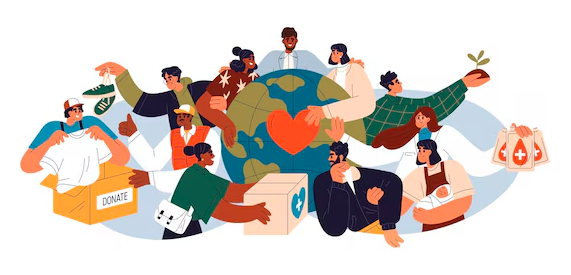How humanitarian aid organizations are reshaping global relief efforts

In a world increasingly affected by natural disasters, conflicts, pandemics, and economic instability, humanitarian aid organizations play a crucial role in responding to crises and providing relief to vulnerable populations. these non-profits serve as the backbone of global emergency response, addressing not only immediate needs like food, water, and shelter, but also long-term recovery, healthcare, and community resilience.
this article explores how humanitarian aid organizations operate, the evolving challenges they face, and the innovations they are using to make a more sustainable and equitable impact across the globe.
understanding the mission of humanitarian aid organizations
at their core, humanitarian aid organizations are dedicated to saving lives, alleviating human suffering, and maintaining human dignity in times of crisis. their operations are rooted in principles of neutrality, impartiality, and independence, which allow them to work in volatile or politically complex environments without bias.
some of the major responsibilities of these organizations include:
- disaster relief after floods, earthquakes, hurricanes, and other natural calamities
- refugee assistance in conflict zones and displacement situations
- medical aid in underserved or epidemic-affected regions
- food security and nutrition programs in famine-prone areas
- education and psychological support for children in post-crisis zones
many also invest in long-term development strategies to ensure that affected communities can rebuild and become self-sufficient after a crisis.
the scope and diversity of aid work
the work of humanitarian organizations varies significantly depending on the size, location, and specialization of the group. for example:
- international ngos like doctors without borders, the international rescue committee, and oxfam operate globally with large teams and sophisticated logistics.
- local non-profits are often the first responders on the ground, especially in rural or conflict-ridden regions where access is restricted.
- faith-based groups combine spiritual outreach with practical assistance.
- specialized organizations focus on niche areas such as water sanitation, education, demining, or shelter.
despite differences in structure or mission, they all contribute toward a unified goal—helping people survive and recover from crisis.
the challenges facing humanitarian aid organizations
while the need for humanitarian intervention continues to grow, aid organizations face a host of complex challenges:
1. funding limitations
many humanitarian aid organizations depend on government grants and public donations. fluctuating economic conditions and donor fatigue can severely impact their ability to sustain operations or scale up during major disasters.
2. logistical constraints
responding quickly and efficiently in areas with damaged infrastructure, limited transportation, or political restrictions is one of the most persistent hurdles in the field.
3. volatility in conflict zones
security concerns often limit access to areas in urgent need, especially in regions controlled by armed groups. aid workers are frequently exposed to threats including kidnapping, violence, and disease.
4. climate change and emerging crises
with climate-induced disasters on the rise, organizations must constantly adapt their strategies to respond to droughts, extreme weather events, and new public health threats like pandemics.
adapting with innovation and technology
to remain effective amid these challenges, humanitarian aid organizations are increasingly turning to innovative tools and technology-driven solutions.
See also: How to Create the Perfect Product for Sensitive Skin
1. drone delivery systems
drones are being used to deliver food, vaccines, and medical supplies to remote or inaccessible regions. in emergencies, they significantly cut down delivery time and bypass damaged infrastructure.
2. blockchain for transparent donations
blockchain technology is improving transparency in donations, ensuring funds are tracked from donors to beneficiaries. it builds trust and reduces corruption or misallocation.
3. mobile-based communication platforms
apps and mobile alerts are now essential for disaster preparedness and real-time coordination between field workers and headquarters.
4. data analytics for rapid response
big data and ai-powered analytics help organizations predict disaster-prone areas, assess needs faster, and allocate resources efficiently.
transparency, accountability, and impact measurement
donors and stakeholders today demand transparency and accountability more than ever. to maintain credibility and secure future funding, humanitarian aid organizations must demonstrate clear impact.
some key ways they are achieving this include:
- publishing audited annual reports and impact assessments
- using third-party platforms to rate and verify non-profit performance
- engaging in community feedback loops to monitor and adjust aid programs
- committing to the humanitarian accountability partnership (hap) and core humanitarian standard (chs)
these frameworks help ensure that operations are ethical, efficient, and effective.
the road ahead: sustainability and future impact
as the world continues to grapple with growing humanitarian needs, the role of humanitarian aid organizations is more critical than ever. looking ahead, several strategies can enhance their effectiveness:
- strengthening local capacity to reduce dependency on external aid
- investing in climate resilience projects such as sustainable agriculture and early warning systems
- developing emergency funds and rapid response units for future pandemics or conflicts
- fostering youth involvement and volunteerism to build a new generation of global humanitarians
sustainability must become a guiding principle, where relief efforts don’t just save lives but also pave the way for long-term development and community empowerment.
conclusion
In every corner of the world—from war zones to flood plains humanitarian aid organizations are on the frontlines of hope, relief, and recovery. their work requires compassion, courage, and creativity in equal measure. despite facing numerous challenges, these organizations continue to innovate, collaborate, and evolve to meet the growing needs of humanity.
whether through technology, partnerships, or grassroots engagement, the impact of their work resonates far beyond crisis moments. supporting and strengthening these efforts is essential—not just for responding to emergencies, but for building a more compassionate and resilient global society.





